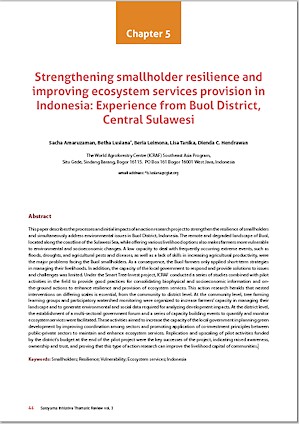| Book Chapter |
 |
|
| Title | Strengthening smallholder resilience and improving ecosystem services provision in Indonesia: Experience from Buol District, Central Sulawesi | | Author | Sacha Amaruzaman, Betha Lusiana, Beria Leimona, Lisa Tanika and Dienda C.P. Hendrawan | | Editors | Suneetha M. Subramanian, Shamik Chakraborty, Beria Leimona, Yohsuke Amano and Kaoru Ichikawa | | Year | 2017 | | Book Title | Sustainable livelihoods in socio-ecological production landscapes and seascapes (Satoyama Initiative Thematic Review vol. 3) | | Volume | 3 | | Pages | 46-57 | | Call Number | BC00482-17 |
|
| Abstract: |
This paper describes the processes and initial impacts of an action research project to strengthen the resilience of smallholders
and simultaneously address environmental issues in Buol District, Indonesia. The remote and degraded landscape of Buol,
located along the coastline of the Sulawesi Sea, while offering various livelihood options also makes farmers more vulnerable
to environmental and socioeconomic changes. A low capacity to deal with frequently occurring extreme events, such as
floods, droughts, and agricultural pests and diseases, as well as a lack of skills in increasing agricultural productivity, were
the major problems facing the Buol smallholders. As a consequence, the Buol farmers only applied short-term strategies
in managing their livelihoods. In addition, the capacity of the local government to respond and provide solutions to issues
and challenges was limited. Under the Smart Tree-Invest project, ICRAF conducted a series of studies combined with pilot
activities in the field to provide good practices for consolidating biophysical and socioeconomic information and onthe-
ground actions to enhance resilience and provision of ecosystem services. This action research heralds that nested
interventions on differing scales is essential, from the community to district level. At the community level, tree farming
learning groups and participatory watershed monitoring were organized to increase farmers’ capacity in managing their
landscape and to generate environmental and social data required for analyzing development impacts. At the district level,
the establishment of a multi-sectoral government forum and a series of capacity building events to quantify and monitor
ecosystem services were facilitated. These activities aimed to increase the capacity of the local government in planning green
development by improving coordination among sectors and promoting application of co-investment principles between
public-private sectors to maintain and enhance ecosystem services. Replication and upscaling of pilot activities funded
by the district’s budget at the end of the pilot project were the key successes of the project, indicating raised awareness,
ownership and trust, and proving that this type of action research can improve the livelihood capital of communities. |
|